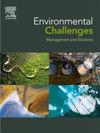Production of ferric ammonium sulfate (FAS) dodecahydrate from pyrite (FeS2)
Q2 Environmental Science
引用次数: 0
Abstract
Pyrite is a waste material typically formed after the extraction of valuable metals from numerous mineral processing circuits, such as copper, gold, and lead. Leaching of pyrite at abandoned mine sites presents significant environmental risks due to the formation of acid mine drainage (AMD). The primary aim of this work was to investigate the recovery of Fe and S from pyrite materials, using acid leaching methods, to produce ferric ammonium sulfate dodecahydrate (FAS; FeNH4(SO4)2·12H2O), which has applications in water treatment, dye industries and metal fabrication. As pyrite samples contain various minerals, the acid leachates contained impurities, such as Al, Ca, Mn, and therefore optimisation studies to produce FAS from pyrite leachates was undertaken based on type of acid, concentration and residence time for leach and crystallisation stages. FAS crystallisation tests were conducted using solutions that were obtained from pyrite leached with nitric acid of 1–5 M, using a crystallisation time of 30 mins, agitation at 400 rpm and at temperatures < 10 °C. Crystals were observed to start forming within 5 mins at this temperature range. This study developed a pathway for FAS synthesis from iron-rich mining waste which occurs at mild conditions and is more direct than traditional FAS synthesis methods.

黄铁矿(FeS2)生产十二水硫酸铁铵(FAS)
黄铁矿是一种废物,通常是在从许多矿物加工回路中提取有价金属(如铜、金和铅)后形成的。黄铁矿在废弃矿区的浸出会形成酸性矿井水(AMD),造成严重的环境风险。本研究的主要目的是研究用酸浸法从黄铁矿中回收铁和S,生产十二水硫酸铁铵(FAS);FeNH4(SO4)2·12H2O),应用于水处理、染料工业和金属制造。由于黄铁矿样品含有各种矿物质,酸性浸出液中含有杂质,如Al, Ca, Mn,因此,根据酸的类型,浓度和浸出和结晶阶段的停留时间,进行了从黄铁矿浸出液中生产FAS的优化研究。FAS结晶试验采用1-5 M硝酸浸出的黄铁矿溶液,结晶时间为30分钟,在400转/分和温度下搅拌;10°C。在此温度范围内,观察到晶体在5分钟内开始形成。本研究开发了一种在温和条件下由富铁采矿废料合成FAS的途径,比传统的FAS合成方法更直接。
本文章由计算机程序翻译,如有差异,请以英文原文为准。
求助全文
约1分钟内获得全文
求助全文
来源期刊

Environmental Challenges
Environmental Science-Environmental Engineering
CiteScore
8.00
自引率
0.00%
发文量
249
审稿时长
8 weeks
 求助内容:
求助内容: 应助结果提醒方式:
应助结果提醒方式:


